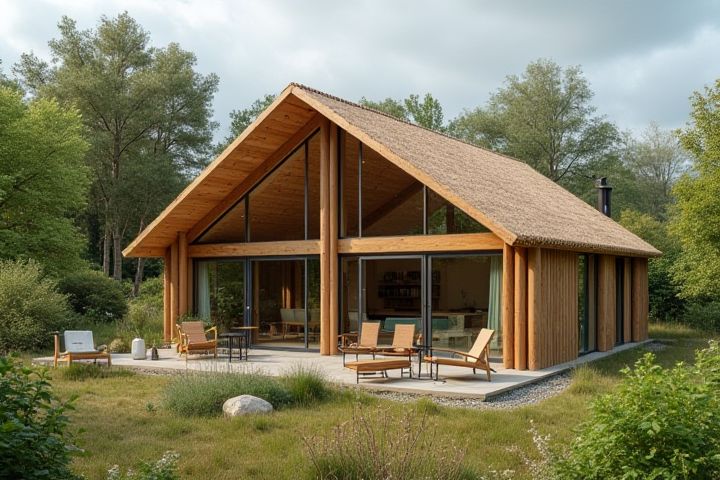
Building a house with eco-friendly materials is not only feasible but increasingly popular among sustainable homeowners. Options such as reclaimed wood, bamboo, and recycled steel provide durability while minimizing environmental impact. Insulation made from sheep's wool or cellulose, derived from recycled paper, enhances energy efficiency and reduces heating costs. Solar panels can be integrated into the design to harness renewable energy, significantly lowering your carbon footprint. Incorporating eco-friendly paint and finishes further ensures a healthier indoor air quality for you and your family.
Can We Build A House With Eco-Friendly Materials
Bamboo as a sustainable resource
Bamboo, known for its rapid growth rate and high strength-to-weight ratio, serves as an excellent sustainable building material for eco-friendly houses. Its natural resilience against pests and its ability to absorb carbon dioxide contribute to a reduced environmental impact compared to traditional lumber. Utilizing bamboo in construction reduces deforestation, promoting biodiversity while offering thermal insulation benefits that enhance energy efficiency. By choosing bamboo, you support sustainable practices and create a healthier living space without compromising on durability or aesthetics.
Recycled steel for structural strength
Building a house with eco-friendly materials, particularly utilizing recycled steel, offers significant structural strength and sustainability benefits. Recycled steel is renowned for its durability, resistance to pests, and ability to withstand extreme weather conditions, making it an ideal choice for home construction. By opting for recycled steel, you reduce environmental impact, as it requires less energy to produce compared to new steel and diverts waste from landfills. Incorporating this material not only enhances the longevity of your home but also contributes to a greener planet.
Rammed earth construction technique
Rammed earth construction utilizes natural materials, primarily soil, to create strong and sustainable structures, showcasing impressive thermal mass properties. This technique typically involves compressing a mixture of soil, clay, and sand in layers between permanent forms, resulting in walls that are durable and energy-efficient. With an average cost of $100 to $300 per square foot, rammed earth can be a cost-effective solution for eco-conscious homeowners, offering a lifespan that can exceed that of traditional materials. You can also integrate other eco-friendly features, such as natural insulation and solar energy systems, to enhance the sustainability of your new home.
Straw bale insulation
Straw bale insulation is an excellent choice for constructing an eco-friendly home, as it utilizes renewable resources that reduce environmental impact. The bales offer superior thermal performance, effectively regulating indoor temperatures and lowering energy consumption. Additionally, straw bales are often cost-effective and locally available, minimizing transportation emissions associated with building materials. Incorporating straw bale insulation not only enhances the sustainability of your home but also promotes a healthy living environment through improved air quality and reduced reliance on synthetic materials.
Reclaimed wood for reduced waste
Reclaimed wood serves as an excellent eco-friendly material for constructing your home, significantly minimizing waste and promoting sustainability. By repurposing timber from old buildings, barns, or pallets, you not only preserve natural resources but also give character and uniqueness to your space. This type of wood often boasts a rich history and naturally weathered appearance, adding aesthetic appeal to both interior and exterior designs. Choosing reclaimed wood can enhance your home's insulation properties and reduce carbon footprint, making it a smart choice for environmentally conscious builders.
Solar panels for renewable energy
Building a house with eco-friendly materials is a sustainable choice that significantly reduces your environmental footprint. Incorporating solar panels provides a renewable energy source, harnessing sunlight to generate electricity and lower utility costs. Other eco-friendly materials, such as reclaimed wood, bamboo flooring, and recycled steel, enhance the energy efficiency and aesthetic appeal of your home. This combination of renewable energy and sustainable building practices not only contributes to a healthier planet but also increases your property's long-term value.
Green roofs for natural insulation
Building a house with eco-friendly materials is entirely feasible, especially when incorporating green roofs for natural insulation. Green roofs, which consist of living vegetation layered over waterproof membranes, can reduce energy consumption by up to 30%, providing effective insulation that maintains indoor temperatures. Your home can benefit from enhanced biodiversity, as green roofs support local flora and fauna while also improving air quality by absorbing pollutants. Additionally, this sustainable approach can increase the property value by up to 20%, making it a financially sound investment for environmentally conscious homeowners.
Low-VOC paints for healthier air
Building a house with eco-friendly materials, particularly incorporating Low-VOC (Volatile Organic Compounds) paints, significantly enhances indoor air quality. These paints typically emit fewer harmful fumes, reducing respiratory issues and improving overall health for occupants. Instructive studies indicate that Low-VOC options can lower indoor air pollution by up to 50%, making your living environment not only safer but more sustainable. By choosing these greener alternatives, you contribute to a healthier lifestyle while promoting environmentally responsible building practices.
Hempcrete as a thermal insulator
Hempcrete is an innovative building material made from the woody core of the hemp plant combined with lime, providing excellent thermal insulation and sustainability. Utilizing Hempcrete in your construction helps regulate indoor temperature and moisture levels, contributing to a healthy living environment. This eco-friendly alternative also features low carbon emissions, making it an attractive option for environmentally conscious homeowners. By opting for Hempcrete, you can reduce your ecological footprint while enjoying the benefits of superior energy efficiency and durability.
Water-efficient plumbing fixtures
Water-efficient plumbing fixtures, such as low-flow faucets, dual-flush toilets, and water-saving showerheads, significantly reduce water consumption in a home. Implementing these fixtures not only conserves precious resources but also lowers utility bills. When paired with eco-friendly materials like bamboo, recycled steel, and sustainable insulation, your house can minimize its environmental footprint. Adopting a holistic approach to building with these elements will create a sustainable living space that meets both your needs and the planet's.
